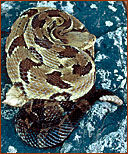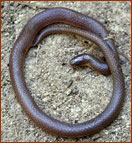|  9:10pm:
I'm in the backseat of the Nissan Pathfinder with a beer in
my hand and a canebrake rattlesnake in my lap. Of course,
the rattlesnake is in a snake bag and the snake bag is in
a plastic container. We're heading back to the hotel to call
it an early, but exciting night. 9:10pm:
I'm in the backseat of the Nissan Pathfinder with a beer in
my hand and a canebrake rattlesnake in my lap. Of course,
the rattlesnake is in a snake bag and the snake bag is in
a plastic container. We're heading back to the hotel to call
it an early, but exciting night.
 7:30pm:
I just turned up Route 264 near Lake Mattamuskeet. We spent
most of the day driving here, but the hunting has been bad
in the middle of the day anyway, so it's the best time to
travel. Jim is in the back seat and Mark is the copilot. The
sun is low enough in the sky to warm my face, but high enough
to heat the blacktop beneath our tires. The day has been a
slow one, but our full stomachs give us new hope. There is
a big X on our map where a dead canebrake rattlesnake was
found in 2000 and that raises our hopes even higher. This
is valuable information when looking for herps. It may not
have been alive, but it means they do inhabit the area. 7:30pm:
I just turned up Route 264 near Lake Mattamuskeet. We spent
most of the day driving here, but the hunting has been bad
in the middle of the day anyway, so it's the best time to
travel. Jim is in the back seat and Mark is the copilot. The
sun is low enough in the sky to warm my face, but high enough
to heat the blacktop beneath our tires. The day has been a
slow one, but our full stomachs give us new hope. There is
a big X on our map where a dead canebrake rattlesnake was
found in 2000 and that raises our hopes even higher. This
is valuable information when looking for herps. It may not
have been alive, but it means they do inhabit the area.
I'm
still accelerating, just waiting to get to the wooded area several
hundred yards ahead, when suddenly we all notice a medium-sized
snake coiled near the center of the road. "Pygmy rattlesnake!
Pygmy rattlesnake!" I swing to the right of the animal and
bring the truck to a full stop as quickly as possibly. Mark leaps
from the vehicle with hook in hand, running back down the road like
a fox after a rabbit - there are no cars behind us, but a "snake
killer" is coming from the other direction. As he reaches the
animal, he can't control his excitement. "Canebrake! Canebrake!"
One of the prized venomous snakes in North Carolina! He and Jim
move it to the safety of the roadside as we break out the snake
bag so we can move it to a safer place and photograph it.
 We
scan the area to make mental notes: the sun is hitting the
road here; there is cane on either side of the road; there
are canals close by that are filled with brackish water. Another
important note is that the snake is swollen with its most
recent meal - probably the reason it was sunning itself. They
need heat from an external source to help them better digest
their food. We
scan the area to make mental notes: the sun is hitting the
road here; there is cane on either side of the road; there
are canals close by that are filled with brackish water. Another
important note is that the snake is swollen with its most
recent meal - probably the reason it was sunning itself. They
need heat from an external source to help them better digest
their food.
  Canebrake
rattlesnakes are closely related to the timber rattlesnakes
(Crotalus horridus horridus) found to the north and
west. As a matter of fact, there has been debate as to whether
they are the same species, a subspecies, or a completely different
species. In Roger Conant's "Reptiles and Amphibians of
the Eastern United States" they are listed as a subspecies,
Crotalus horridus atricaudatus. They're beautiful snakes,
a little more on the reddish-pink side than the timbers, with
a dark red line down the back, or sometimes a soft pink one.
Adults can reach a length of up to five feet; this one is
a young animal at about two feet long. They inhabit the lowland
swamps and cane thickets throughout the southeastern US, except
for the Florida peninsula. Canebrake
rattlesnakes are closely related to the timber rattlesnakes
(Crotalus horridus horridus) found to the north and
west. As a matter of fact, there has been debate as to whether
they are the same species, a subspecies, or a completely different
species. In Roger Conant's "Reptiles and Amphibians of
the Eastern United States" they are listed as a subspecies,
Crotalus horridus atricaudatus. They're beautiful snakes,
a little more on the reddish-pink side than the timbers, with
a dark red line down the back, or sometimes a soft pink one.
Adults can reach a length of up to five feet; this one is
a young animal at about two feet long. They inhabit the lowland
swamps and cane thickets throughout the southeastern US, except
for the Florida peninsula.
 The
day had been a slow one, but this has made up for it a hundred
times over. Continuing down the road we found a beautiful
ribbon snake that had recently been hit by a car but was still
alive, and another small canebrake - this one killed on the
edge of the road. It's sad to see so many animals loose their
lives on these roads. The
day had been a slow one, but this has made up for it a hundred
times over. Continuing down the road we found a beautiful
ribbon snake that had recently been hit by a car but was still
alive, and another small canebrake - this one killed on the
edge of the road. It's sad to see so many animals loose their
lives on these roads.
By
9:00pm we decide to call it a night so we can get up early, photograph
the Canebrake, and release it in a safe spot far from traffic.
|
 |
 |
|
Canebrake
rattlesnake
Ribbon snake
Black Racers (DOR)
Northern Watersnake
Worm snake
Eastern Glass Lizard (DOR)
Broad-head Skink
|
|
 |
| |
 |
| |
 |
| |
 |
| (1)
Canebrake rattlesnake
(2)
Driving in NC
(3)
Canebrake near roadside
(4)Canebrake
rattlesnake
(5)
Timber rattlesnake
(6)
Worm snake
|
|
 |
| |
|
|
